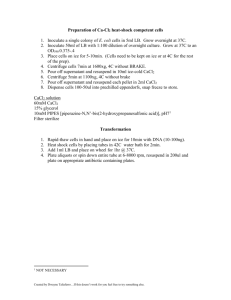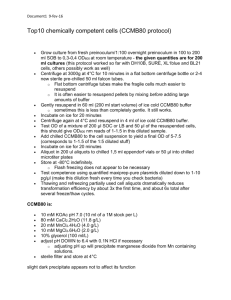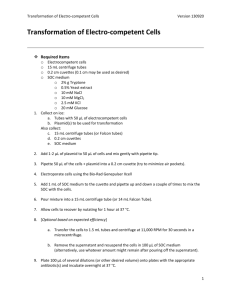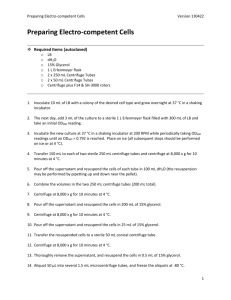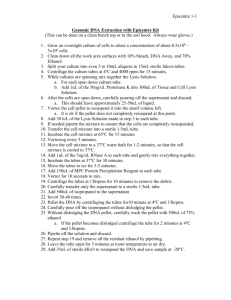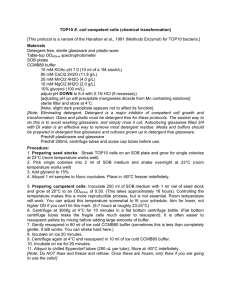Preparation of Competent Cells
advertisement
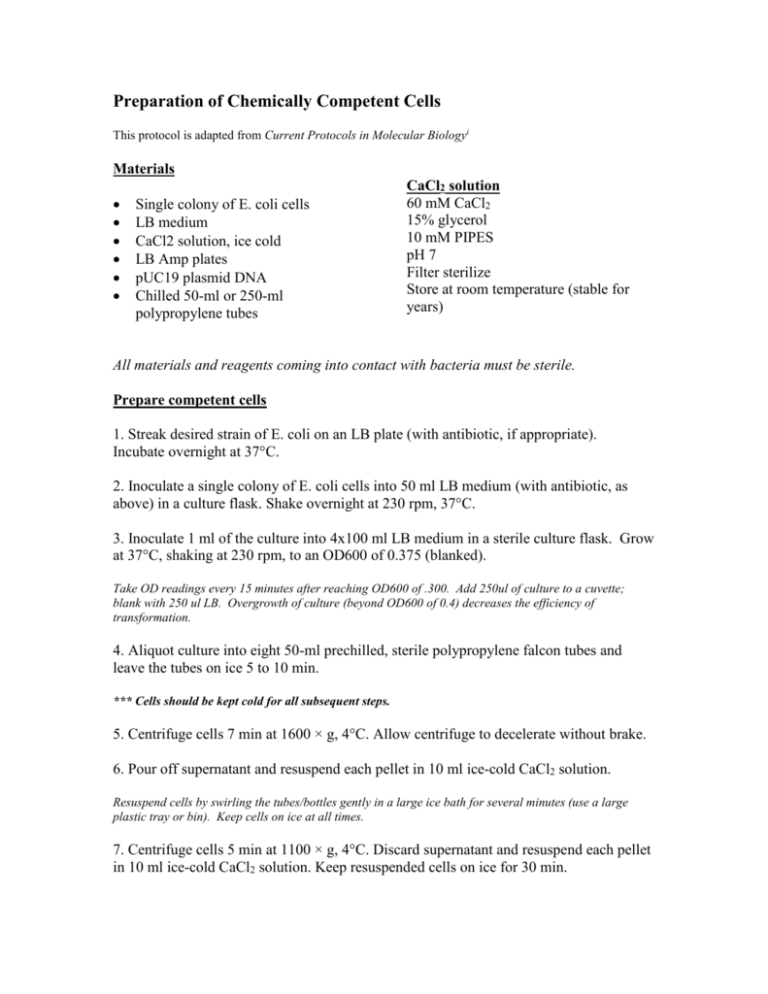
Preparation of Chemically Competent Cells This protocol is adapted from Current Protocols in Molecular Biologyi Materials Single colony of E. coli cells LB medium CaCl2 solution, ice cold LB Amp plates pUC19 plasmid DNA Chilled 50-ml or 250-ml polypropylene tubes CaCl2 solution 60 mM CaCl2 15% glycerol 10 mM PIPES pH 7 Filter sterilize Store at room temperature (stable for years) All materials and reagents coming into contact with bacteria must be sterile. Prepare competent cells 1. Streak desired strain of E. coli on an LB plate (with antibiotic, if appropriate). Incubate overnight at 37°C. 2. Inoculate a single colony of E. coli cells into 50 ml LB medium (with antibiotic, as above) in a culture flask. Shake overnight at 230 rpm, 37°C. 3. Inoculate 1 ml of the culture into 4x100 ml LB medium in a sterile culture flask. Grow at 37°C, shaking at 230 rpm, to an OD600 of 0.375 (blanked). Take OD readings every 15 minutes after reaching OD600 of .300. Add 250ul of culture to a cuvette; blank with 250 ul LB. Overgrowth of culture (beyond OD600 of 0.4) decreases the efficiency of transformation. 4. Aliquot culture into eight 50-ml prechilled, sterile polypropylene falcon tubes and leave the tubes on ice 5 to 10 min. *** Cells should be kept cold for all subsequent steps. 5. Centrifuge cells 7 min at 1600 × g, 4°C. Allow centrifuge to decelerate without brake. 6. Pour off supernatant and resuspend each pellet in 10 ml ice-cold CaCl2 solution. Resuspend cells by swirling the tubes/bottles gently in a large ice bath for several minutes (use a large plastic tray or bin). Keep cells on ice at all times. 7. Centrifuge cells 5 min at 1100 × g, 4°C. Discard supernatant and resuspend each pellet in 10 ml ice-cold CaCl2 solution. Keep resuspended cells on ice for 30 min. 8. Centrifuge cells 5 min at 1100 × g, 4°C. Discard supernatant and resuspend each pellet in 2 ml ice-cold CaCl2 solution. It is important to resuspend this final pellet well. 9. At final resuspension, remove two 100ul aliquots of the bacterial suspension to prechilled, autoclaved 1.7ml microcentrifuge tubes. Place in –80 for 1hr. Perform the protocol below to assess cell competency. Leave the remainder of the bacterial suspension on ice overnight (you can place the ice bath at 4oC). 10. The next day, check control plates: if there are colonies, assume the cells are contaminated with plasmid and discard the entire batch. If there are no colonies, proceed to aliquoting. 11. Be certain the pipet tip you use for dispensing is sterile. The introduction of an amplicillin-resistant (i.e. plasmid-carrying) bacterial contaminant at this point will ruin the whole prep. Sterilize repeat pipettor tip by drawing up and dispensing isopropanol several times (tips are not autoclavable). Dispense cells into prechilled, autoclaved 1.7ml microcentrifuge tubes in 100ul aliquots. Freeze immediately at –80°C. Assess competency of cells and test for plasmid contamination 12. Use 20picograms (pg) of pUC 19 to transform 100 µl of competent cells, and plate the cells on LB-Amp plate. Transform a second negative control with zero plasmid, and plate half this culture on an LB-Amp plate and half on an LB-Kan plate. Incubate all plates at 37°C overnight. 13. There should be no colonies on the control plates. If there are colonies, assume the cells are contaminated with plasmid and discard the entire batch. Calculate the number of transformant colonies per microgram(ug) of pUC19 per 100ul aliquot: # colonies/20pg x 106pg/ug = #colonies/ug Record your results in the competent bug log. 107 colonies/ug is ideal; if below 106, the batch should be discarded. Competency of strains decreases very slowly over months of storage time. Seidman, Christine E. “Basic Protocol 1: Transformation Using Calcium Chloride.” UNIT 1.8 Introduction of Plasmid DNA into Cells. Current Protocols in Molecular Biology, 2005. http://www3.interscience.wiley.com/cgi-bin/mrwhome/104554809/HOME ii
